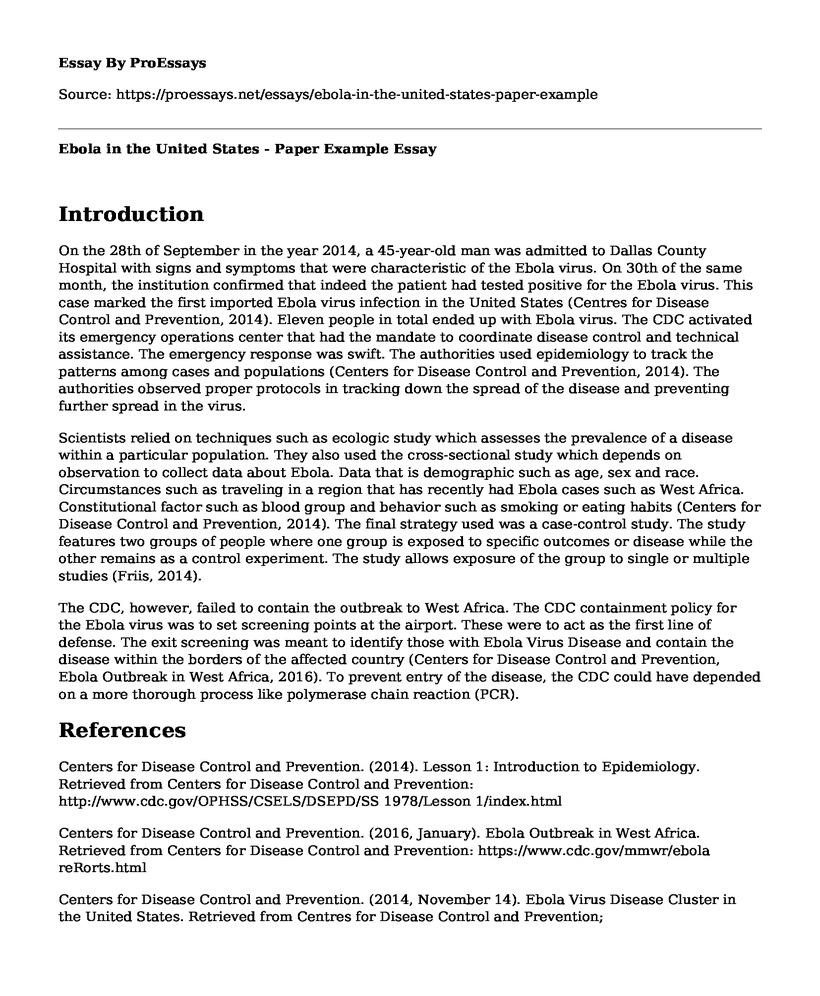Introduction
On the 28th of September in the year 2014, a 45-year-old man was admitted to Dallas County Hospital with signs and symptoms that were characteristic of the Ebola virus. On 30th of the same month, the institution confirmed that indeed the patient had tested positive for the Ebola virus. This case marked the first imported Ebola virus infection in the United States (Centres for Disease Control and Prevention, 2014). Eleven people in total ended up with Ebola virus. The CDC activated its emergency operations center that had the mandate to coordinate disease control and technical assistance. The emergency response was swift. The authorities used epidemiology to track the patterns among cases and populations (Centers for Disease Control and Prevention, 2014). The authorities observed proper protocols in tracking down the spread of the disease and preventing further spread in the virus.
Scientists relied on techniques such as ecologic study which assesses the prevalence of a disease within a particular population. They also used the cross-sectional study which depends on observation to collect data about Ebola. Data that is demographic such as age, sex and race. Circumstances such as traveling in a region that has recently had Ebola cases such as West Africa. Constitutional factor such as blood group and behavior such as smoking or eating habits (Centers for Disease Control and Prevention, 2014). The final strategy used was a case-control study. The study features two groups of people where one group is exposed to specific outcomes or disease while the other remains as a control experiment. The study allows exposure of the group to single or multiple studies (Friis, 2014).
The CDC, however, failed to contain the outbreak to West Africa. The CDC containment policy for the Ebola virus was to set screening points at the airport. These were to act as the first line of defense. The exit screening was meant to identify those with Ebola Virus Disease and contain the disease within the borders of the affected country (Centers for Disease Control and Prevention, Ebola Outbreak in West Africa, 2016). To prevent entry of the disease, the CDC could have depended on a more thorough process like polymerase chain reaction (PCR).
References
Centers for Disease Control and Prevention. (2014). Lesson 1: Introduction to Epidemiology. Retrieved from Centers for Disease Control and Prevention: http://www.cdc.gov/OPHSS/CSELS/DSEPD/SS 1978/Lesson 1/index.html
Centers for Disease Control and Prevention. (2016, January). Ebola Outbreak in West Africa. Retrieved from Centers for Disease Control and Prevention: https://www.cdc.gov/mmwr/ebola reRorts.html
Centers for Disease Control and Prevention. (2014, November 14). Ebola Virus Disease Cluster in the United States. Retrieved from Centres for Disease Control and Prevention; https://www.cdc.gov/mmwr/preview/mmwrhtml/mm63e1114a5. HTML
Friis, R. H. (2014). Study Designs: Ecologic, Cross-Sectional, Case Control. In R. H. Friis, Epidemiology for Public Health Practice (pp. 279-319). Burlington, Massachusetts, United States: Jones & Bartlett Learning. Retrieved August 23, 2018, from https://www.chegg.com/homework-help/define-words-following-terms-ecologic-studyb-ecologic-compa-chapter-6-problem-1sqe-solution-9781449651602-exc
Cite this page
Ebola in the United States - Paper Example. (2022, Jul 21). Retrieved from https://proessays.net/essays/ebola-in-the-united-states-paper-example
If you are the original author of this essay and no longer wish to have it published on the ProEssays website, please click below to request its removal:
- Paper Example on Different Sugars
- Health Problems Among Seniors Essay
- Social Work Practice and Health Care Access Among Hispanic Immigrants
- The Relationship Between Executive Functions and Lack of Sleep Essay
- Essay Sample on Managing Emergencies and Crisis
- Paper Example on Exercise for Health: Benefits of Physical Activity
- Master's Degree in Nursing: Exploring Global Health Challenges & Leadership







